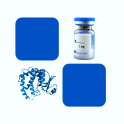
- Remove this product from my favorite's list.
- Add this product to my list of favorites.
Products
Viewed products
Newsletter
 |  |  |  |  |  |

Background
The very-low-density-lipoprotein receptor (VLDL-R) is a lipoprotein receptor that shows considerable similarity to the lowdensity-lipoprotein receptor. VLDL R is a 130 kDa type I transmembrane protein in the LDL receptor family that plays a significant role in lipid metabolism and in nervous system development and function .This receptor has been suggested to be important for the metabolism of apoprotein-E-containing triacylglycerol-rich lipoproteins, such as very-low-densitylipoprotein (VLDL), beta-migrating VLDL and intermediate-density lipoprotein. It is also one of the receptors of reelin, an extracellular matrix protein which regulates the processes of neuronal migration and synaptic plasticity. In humans, the VLDL-R is encoded by the VLDLR gene.
A rare neurological disorder first described in the 1970s under the name "disequilibrium syndrome" is now considered to be caused by the disruption of VLDLR gene. The disorder was renamed VLDLR-associated cerebellar hypoplasia (VLDLRCH) after a 2005 study. It is associated with parental consanguinity and found in secluded communities such as the Hutterites. VLDLRCH is one of the two known genetic disorders caused by a disruption of reelin signaling pathway, along with Norman-Roberts syndrome.
Source
Recombinant Human VLDL R, His Tag (VLR-H5227) is expressed from human 293 cells (HEK293). It contains AA Gly 28 - Ser 769 (Accession # P98155-2).
Predicted N-terminus: Gly 28
Molecular Characterization
This protein carries a polyhistidine tag at the C-terminus.
The protein has a calculated MW of 84.0 kDa. The protein migrates as 90-110 kDa under reducing (R) condition (SDS-PAGE) due to different glycosylation.
Endotoxin
Less than 1.0 EU per μg by the LAL method.
Purity
>90% as determined by SDS-PAGE.
Formulation
Lyophilized from 0.22 μm filtered solution in PBS, pH7.4 with trehalose as protectant.
Reconstitution
Please see Certificate of Analysis for specific instructions.
For best performance, we strongly recommend you to follow the reconstitution protocol provided in the CoA.
Storage
For long term storage, the product should be stored at lyophilized state at -20°C or lower.
Please avoid repeated freeze-thaw cycles.
This product is stable after storage at:
-20°C to -70°C for 12 months in lyophilized state;
-70°C for 3 months under sterile conditions after reconstitution.
Bioactivity
Please refer to product data sheet.
(1) "Separation of Lipoproteins for Quantitative Analysis of 14C-Labeled Lipid-Soluble Compounds by Accelerator Mass Spectrometry"
Chuang, Clifford, Kim et al
Int J Mol Sci (2024) 25 (3)
(2) "Insights into the influence of three types of sugar on goose fatty liver formation from endoplasmic reticulum stress (ERS)"
Wei, Han
Poult Sci (2024) 103 (3), 103466
(3) "Causal association between 637 human metabolites and ovarian cancer: a mendelian randomization study"
Huang, Lin, Zheng
BMC Genomics (2024) 25 (1), 97
Showing 1-3 of 1506 papers.
Follow us